REPORT:
THE HAN RIVER SPORTING LIFESTYLE IN SEOUL
High-density megacities generally struggle to incorporate green space and infrastructure for recreation and sporting activities into their urban spatial structure. To overcome this evident challenge, over the past decades Seoul has put much effort into designing a network of riverside trails and clusters of outdoor fitness zones along its iconic Han River, resulting in the rise of its outdoor sporting lifestyle. This SPORTIFY CITIES report offers a brief overview of this noteworthy riverside culture.
The Han River Network of Trails
Seoul, the capital of South Korea, is one of the most populous cities in the developed world, with a current population of more than 10 million (within its administrative city boundaries). Since the 1960s the rapid rise in economic activity, increase in standards of living and the breath-taking urban development have transformed this megacity into a global economic and cultural powerhouse. This remarkable period of urban modernization was coined as the ‘Miracle on the Han River’, referring to South Korea’s major river that flows through the geographic centre of present Seoul.
Over the past couple of decades the Han River and its adjunct streams have also become the centre of Seoul’s outdoor sporting culture. The local government has put plenty of effort into transforming the city’s riverbanks into ecological and recreational zones by creating various parks and sporting grounds along the main river. The core pillar of the city’s outdoor sporting lifestyle, though, is the remarkable river trail network totalling more than 150km of well-maintained paved bicycle and jogging tracks. Apart from the Han River, the city’s three tributaries (streams) – Tancheon, Jungnangcheon and Anyangcheon – and several adjunct creeks are also integrated into this extensive trail network.
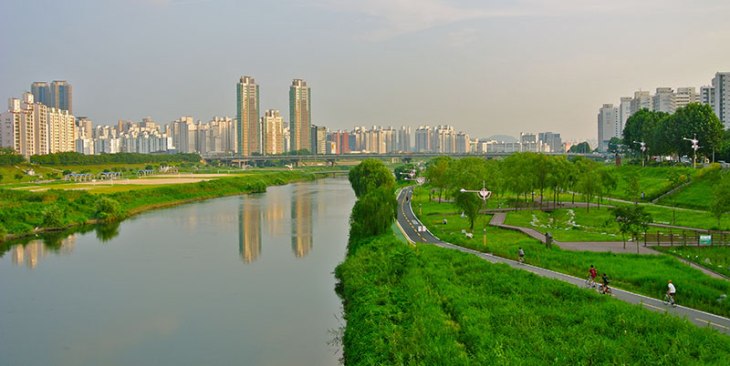
The 15-km long trail along the Anyangcheon stream (and along the Seobu expressway) connects the south-western outskirts of Seoul with the centrally located Han River. During the cold winter months, however, the lush green space along the city’s streams typically turns into a less appealing reddish-yellow tundra-style vegetation.

In the affluent residential area of Gangnam-Gu scenic trails along the nearly 10-km long Yangjaecheon stream provide local residents with convenient outdoor sporting options. It is one of the few expressway-free river zones in the entire city.
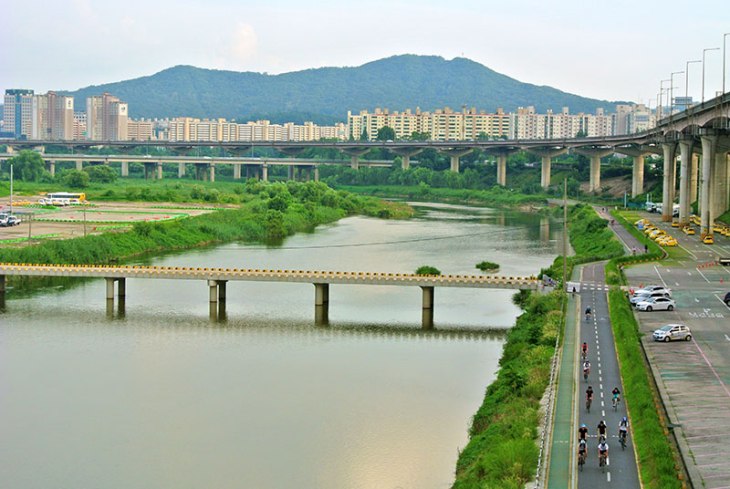
The south-eastern Tancheon stream with its bicycle and running trail and its elevated Dongbu expressway divides the two large residential areas of Gangnam-gu and Songpa-gu. This trail, too, is linked to the expansive Han River bicycle trail network.
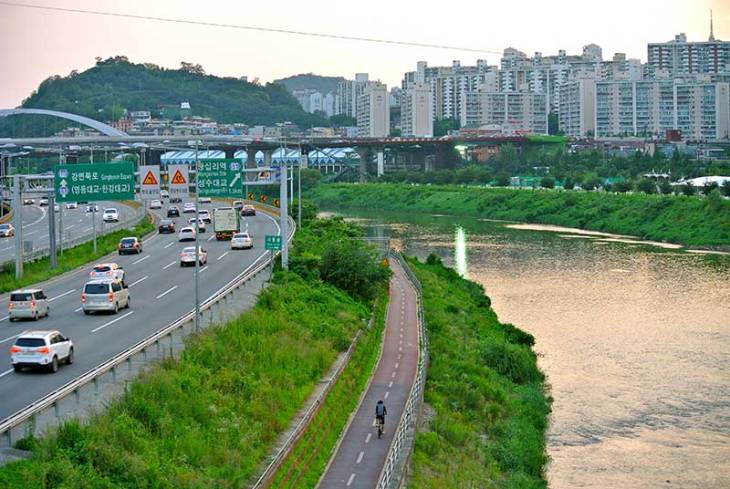
The Jungnangcheon trail cuts through the north-eastern districts of Seoul. For recreational cyclists and joggers residing in the northern districts of the megacity this stream is the only available link to the Han River trail network.
On weekday evenings and weekends, many Seoulites flock to the various riverside trails, where they can enjoy carrying out their after-work physical activities. During warmer spring, summer and autumn days cycling appears to be the sporting activity of choice, with cyclists clearly outnumbering the joggers and walkers along much of the Han riverbank area. Given that most cyclists do not carry any back bags, it can be assumed that they start their recreational cycling trips from their residential districts (neither short- nor long-distance bicycle commuting to/from work is particularly popular with Seoul residents).
As most bicycle trails are located next to or under the large network of elevated expressways, sporty residents are almost constantly exposed to noise and air pollution produced by the high-volume of motorized traffic (the commuters’ share is roughly evenly split between the three main transportation modes: around 35% of Seoulites choose the metro train, 28% take the bus and around 25% drive private cars when commuting to workplace – according to official figures).
 Many cyclists can be spotted wearing anti-pollution N95-masks, implying that the levels of air pollutants along the river system may be of concern. PM2.5, the particulate matter of less than 2.5 micrometres, for instance, is such air pollutant that is able to penetrate deeply into the respiratory tract and increase the risk of respiratory and cardiovascular diseases. With an annual average of 22 μg/m3 Seoul’s PM2.5 value is at the top end of the range among developed cities, as illustrated in the graph below. Given that the majority of the city’s bicycle trails are located in close proximity to congested expressways the actual levels of air pollution along the trails are likely to be higher than this official PM2.5 value, putting cyclists, walkers and runners at higher risk.
Many cyclists can be spotted wearing anti-pollution N95-masks, implying that the levels of air pollutants along the river system may be of concern. PM2.5, the particulate matter of less than 2.5 micrometres, for instance, is such air pollutant that is able to penetrate deeply into the respiratory tract and increase the risk of respiratory and cardiovascular diseases. With an annual average of 22 μg/m3 Seoul’s PM2.5 value is at the top end of the range among developed cities, as illustrated in the graph below. Given that the majority of the city’s bicycle trails are located in close proximity to congested expressways the actual levels of air pollution along the trails are likely to be higher than this official PM2.5 value, putting cyclists, walkers and runners at higher risk.
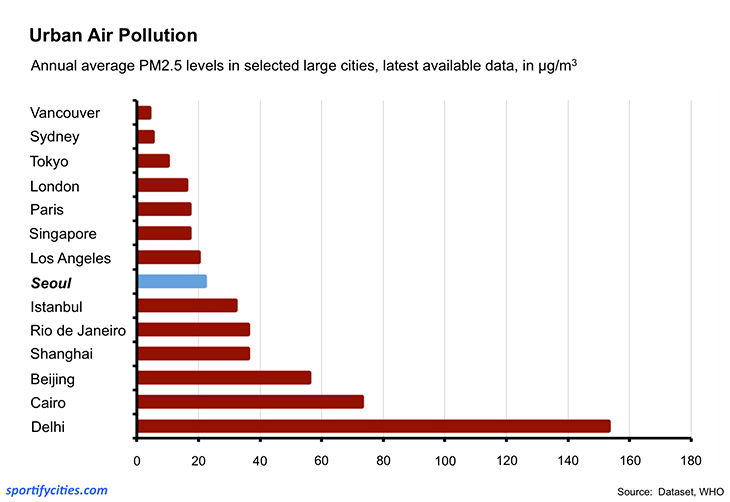
Annual mean concentrations of PM2.5, a key air pollutant, in selected large cities worldwide. Compared to other Asian cities Seoul’s air quality is within acceptable levels.

The Han River trails are typically located either next to or under the elevated expressways.

In Seoul shared-use bridges for cyclists, joggers and walkers are in demand, as most bridges crossing the Han River have been built to accommodate the motorized traffic.
Riverside Outdoor Gyms
A laudable feature of Seoul’s bicycle and jogging riverside trail network is the concept of free-to-use outdoor gym areas. These supplementary riverside fitness zones typically consist of 10 to 15 gym stations, ranging from body weight-supportive strength equipment, flexibility apparatuses to endurance-assisting elliptical cross-trainers. They seem to be fairly popular with residents who live within walking distance to the riverside as well as joggers and cyclists who utilise these fitness facilities during their aerobic activities.
Yet despite the popularity of this outdoor gym concept, the restrictive nature of these fitness stations provides users with only limited health benefits – for instance, body weight-dependent machines and resistance-invariable elliptical cross-trainers can not be adjusted to the actual personal strength levels. That said, the compactness and diversification of the existing fitness areas along the Han River tick off the most crucial aspects of a comprehensive outdoor gym zone, merging the endurance and strength elements and making the zone a viable fitness option for residents with basic physical requirements (for more information on this topic, please read the chapter ‘Outdoor fitness stations’ in the special report ‘Singapore – A high-density city with sporting characters’).
The main downside of these Han River outdoor gym zones, though, is their location choice – they are usually situated under elevated expressways or large bridges. Furthermore, the beautification aspect of these fitness areas appears to have been a low priority; that is, the greyness of nearby concrete highway pillars and the dullness of the surroundings would certainly benefit from some revitalization efforts.

Riverside gym zones consisting of various fitness machines are regularly installed under elevated expressways.

In an attempt to make the greyish outdoor gym zones look more appealing, the pillars of the Gangbyeon expressway and the fitness equipment are occasionally beautified with paintings and colourful features.

Located along the bike and walking trails the outdoor gym equipment is popular with recreational cyclists and local dog owners.

Installed outdoor fitness stations with a ‘scenic’ view on the Gangbyeon expressway.
Parkland – Yeouido Business District
The network of cycling and running trails is also connected with several riverside parks and recreational areas. The largest park area is the World Cup Park, which was designed for the 2002 Soccer World Cup. It is located in the eastern outskirts of the city (in the Mapo-Gu district) and it includes a soccer field, basketball courts, baseball fields, track and field stadium, golf course, skate park and jogging trails.
Another laudable park is the inner-city Yeouido-Hangang Park, which is located within walking distance to the Yeouido Business District. The riverside is popular with both residents and tourists, offering a large campground and vast space for outdoor festivals. Attached to the riverside park is a multi-purpose park area, the Yeouido Park, consisting of basketball courts, a rather shabby-looking outdoor gym ground with several free-to-use standard fitness facilities and a bike rental place. The park also features an oval-shaped track of 2.5 km, which is subdivided into an all-weather rubberized running section as well as a paved bicycle lane.
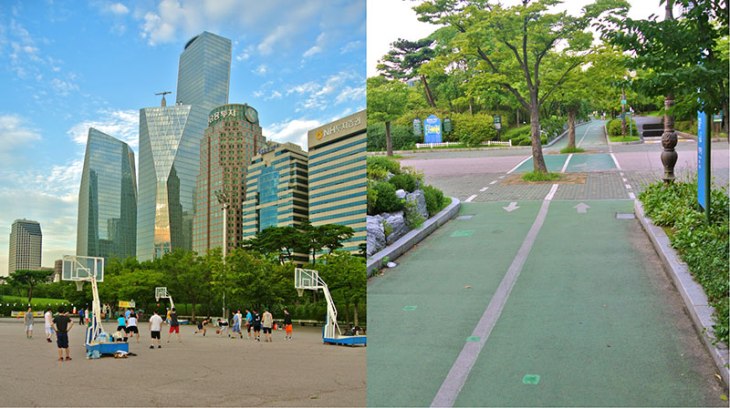
Located next to the Yeouido Business District and the Han River, the Yeouido Park has been transformed into a key inner-city recreational and sporting area.
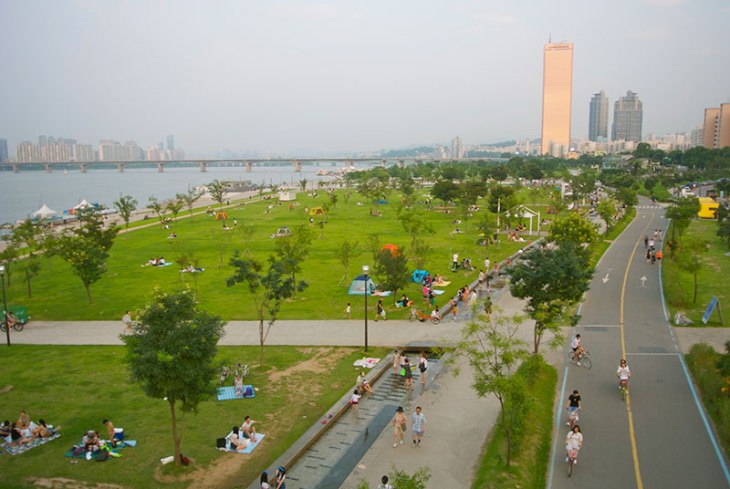
The southern Han River trail bypasses the Yeouido-Hangang Park, which is famous for its large riverside campground.
Urban Sporting Lifestyle Zone …..but not for all
The transformation of the previously polluted Han riverside areas into an outdoor sporting lifestyle and recreational zone is an inspiring demonstration of political will. The accessibility to this extensive network of bicycle and jogging riverside trails and its adjunct parks, however, is largely limited to residents who live within walking or cycling distance to one of the rivers or streams. And although driving plays a significant role in commuting, approximately 25% of Seoulites use private vehicles to get to workplace, it is very challenging to find car park areas near the long riverbanks.
This limited accessibility appears to be a critical issue, with a considerably large proportion of Seoulites being cut off from the city’s prime outdoor sporting zone. To make matters worse, the network of riverside trails with its adjunct parks remains the key – and perhaps the only – sporting lifestyle zone for local residents; since no large-scale public sporting facilities and no multi-purpose public parks are systematically integrated into the city’s urban planning concept, residents living in both older districts with low-rise apartment buildings and newer high-rise condominium estates are greatly restricted in their sporting choices.
For all these reasons, Seoul’s outdoor sporting culture will remain physically confined to its river and stream system for decades to come, limiting the city’s chances of ever becoming a key urban sporting lifestyle hub.

Across the city of Seoul outdoor fitness zones – typically comprising of a small number of gym facilities – are regularly embedded into the modern high-rise, high-density residential estates. In many cases, however, the location of such well-intentioned fitness zones appears to be poorly chosen.
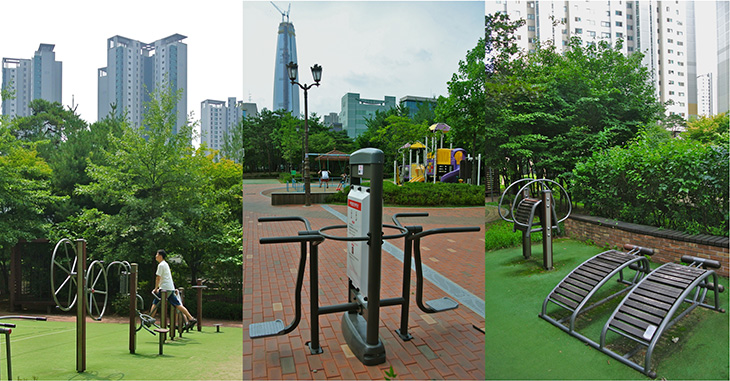
Although outdoor gym facilities are usually integrated into the growing number of recently established high-rise estates in the northern parts of Seoul, the fitness zones located in the southern – more affluent – districts of Songpa-gu, Gangnam-gu and Seocho-gu offer a slightly higher quality. In general, however, the range of apparatus and devices within these small outdoor fitness zones is mostly inadequate, providing local residents with only limited fitness options.

Cheonggyecheon, a fairly recently restored 11km-long narrow stream, cuts through the city’s older northern districts. This beautified recreation space has been marketed to potential foreign visitors as a must-see attraction in the hope of improving Seoul’s image as a Green City.
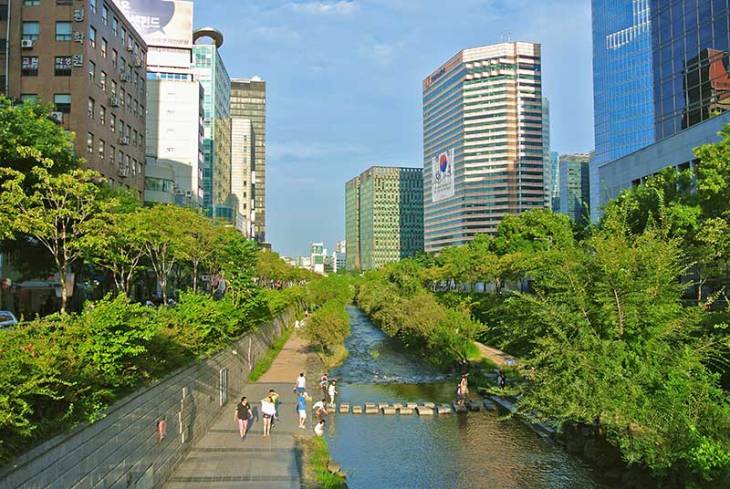
Despite being physically linked to the Han River trail network via the large Jungnangcheon stream, this re-constructed Cheonggyecheon canal is of little use for sporty local residents, lacking any network of cycling or running trails.
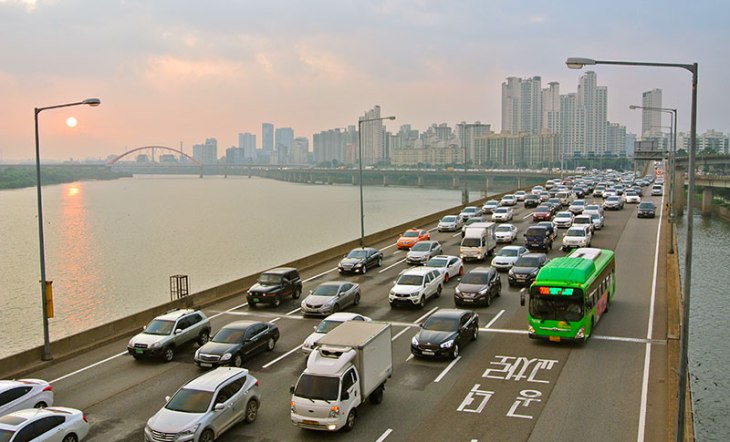
In the late 1960s the Seoul Metropolitan Government instigated fundamental planning policies, resulting in modernisation, housing decentralisation, transport diversification and urban expansion. The downside of this transformational urban policy is the extensive network of elevated expressways, which has become a permanent fixture of the city’s river and stream system.
